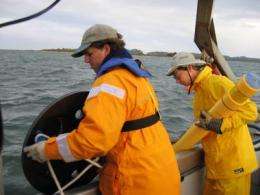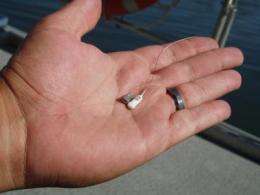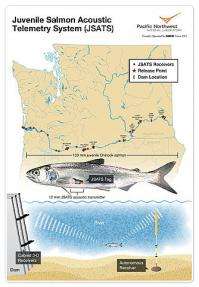PNNL researchers place yellow acoustic receivers into the Columbia River. The receivers are part of Juvenile Salmon Acoustic Telemetry System, which is helping track the movement of tagged fall Chinook salmon on the Clearwater River in Idaho. Credit: Pacific Northwest National Laboratory
(PhysOrg.com) -- Temperature differences and slow-moving water at the confluence of the Clearwater and Snake rivers in Idaho might delay the migration of threatened juvenile salmon and allow them to grow larger before reaching the Pacific Ocean.
A team of Northwest researchers are examining the unusual life cycle of the Clearwater's fall Chinook salmon to find out why some of them spend extra time in the cool Clearwater before braving the warm Snake. The Clearwater averages about 53 degrees Fahrenheit in the summer, while the Snake averages about 71. The confluence is part of the Lower Granite Reservoir - one of several sections of slow water that are backed up behind lower Snake and Columbia river dams - that could reduce fish's cues to swim downstream.
The delayed migration could also mean Clearwater salmon are more robust and survive better when they finish their ocean-bound trek, said Billy Connor, a fish biologist with the U.S. Fish & Wildlife Service.
"It may seem counterintuitive, but the stalled migration of some salmon could actually help them survive better," Connor said. "Juvenile salmon may gamble on being able to dodge predators in reservoirs so they can feast on the reservoirs' rich food, which allows them to grow fast. By the time they swim toward the ocean the next spring, they're bigger and more likely to survive predator attacks and dam passage."
Scientists from the U.S. Geological Survey, the U.S. Fish & Wildlife Service, the Department of Energy's Pacific Northwest National Laboratory and the University of Washington are wrapping up field studies this fall to determine if water temperature or speed encourage salmon to overwinter in the confluence and in other reservoirs downstream. The Bonneville Power Administration is funding the research to help understand how Snake and Columbia River dams may affect fish.
USGS and USFWS are tracking fish movement by implanting juveniles with radio tags, which are more effective in shallow water. PNNL is complementing that effort with acoustic tags, which work better in deeper water. PNNL is also contributing its hydrology expertise to measure the Clearwater and Snake rivers' physical conditions. UW is providing the statistical analysis of the tagging.
"Fall Chinook salmon on the Clearwater River have a fascinating early life history that may contribute to their successful return as adults," said PNNL fish biologist Brian Bellgraph. "If we can support the viability of such migration patterns in this salmon subpopulation, we will be one step closer to recovering the larger fall Chinook salmon population in the Snake River Basin."
An acoustic tag (left) and a radio tag (white, with wires) sit in the palm of a researcher's hand. Both acoustic and radio tags are being implanted in juvenile fall Chinook salmon to track their movement at the confluence of the Clearwater and Snake rivers near Lewiston, Idaho. Credit: Pacific Northwest National Laboratory
Scientists used to think all juvenile fall Chinook salmon in the Clearwater River migrated to the ocean during the summer and fall after hatching in the spring. But researchers from USGS, USFWS and the Nez Perce Tribe began learning in the early 1990s that some stick around until the next spring. Similar delays have also been found in a select number of other rivers, but this is still the exception rather than the rule. The Clearwater is unique because a high number - as much as 80 percent in some years - of its fall Chinook salmon don't enter the ocean before they're a year old.
To better understand how fish react to the river's physical conditions, scientists are implanting juvenile salmon with the two types of small transmitters that emit different signals. The transmitters - commonly called tags - are pencil eraser-sized devices that are surgically implanted into young fish 3.5 to 6 inches in length. Specially designed receivers record the tags' signals, which researchers use to track fish as they swim. The gathered data helps scientists measure how migration is delayed through the confluence.
Radio tags release radio waves, which are ideal to travel through shallow water and air. And acoustic tags emit higher-frequency sounds, or "pings," that more easily move through deeper water. The acoustic tags being used are part of the Juvenile Salmon Acoustic Telemetry System, which PNNL and NOAA Fisheries developed for the U.S. Army Corps of Engineers.
The Juvenile Salmon Acoustic Telemetry System (JSATS) helps determine the survival rate of juvenile salmon in the Columbia River estuary by tracking fish as they migrate to the ocean. Just 0.43 grams and smaller than a pencil eraser, JSATS tags are the smallest acoustic tags available. After being inserted into the belly of juvenile salmon, acoustic tags emit a small sound, or "ping," every few seconds that is detected by receivers strategically placed in waterways. Each tag transmits a different code, which allows individual fish to be identified. The receivers record the ping's position and use that data to trace where each tagged fish travels.
Together, fish tagged with both acoustic and radio transmitters help create a more comprehensive picture of how the river affects fish travel. The location data can also indicate how well fish fare. If a tag's signal stops moving for an extended period, the fish in which it was implanted might have died. Researchers examine the circumstances of each case to determine the fish's fate.
This study is a unique example of how both tag technologies can jointly determine the survival and migration patterns of the relatively small juvenile fall Chinook salmon. The size of transmitters has decreased considerably in recent years; further size reductions would allow researchers to study even smaller fall Chinook salmon. This could provide further insight into this mysterious migration pattern.
Beyond the fish themselves, researchers will also examine water temperature and flow to determine what correlation the river's physical conditions may have with the fish movement. Salmon use water velocity and temperature as cues to guide them toward the ocean. But the Lower Granite Dam's reservoir, which extends about 39 miles upriver from the dam to Lewiston, makes the water in the Clearwater River's mouth move slowly. Researchers suspect the slow water may encourage some fall juvenile Chinook salmon to delay their journey and spend the winter in the confluence.
To test this hypothesis, PNNL scientists take periodic velocity measurements in the confluence from their research boat. Submerged sensors have recorded water temperatures every few minutes between about June and January since 2007. Both sets of information will be combined to create a computational model of the fish's river habitat.
This study's results could be used to modify river water flow to improve fish survival. The Clearwater's Dworshak Dam already helps manage water temperature by strategically releasing cool water toward the Snake. The waters form thermal layers - with the Snake's warm water on top and the Clearwater's cool liquid below - that fish move through to regulate their body temperatures.
Source: Pacific Northwest National Laboratory (news : web)





















